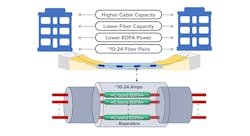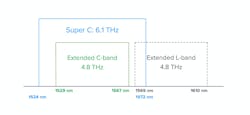As demand for bandwidth continues to double every two to three years, network operators need to find cost-effective ways of scaling optical network capacity. There are essentially only two ways of increasing capacity: increased spectral efficiency and spectrum expansion.
Pre-Coherent Capacity Gains From More Spectrum and Better Spectral Efficiency
In the pre-coherent era, both techniques were used at different times. Spectral efficiency and fiber capacity saw a fourfold increase as the industry moved from 2.5 Gb/s direct-detect wavelengths to 10 Gb/s direct-detect wavelengths. Spectral efficiency and fiber capacity were also doubled by moving from 100 GHz channel spacing to 50 GHz spacing, which enabled the number of wavelengths in a given amount of C-band spectrum to double. There was even some limited adoption of 25 GHz spacing, which enabled the number of 10 Gb/s wavelengths to double again.
The amount of spectrum also increased. Outside of Japan, DWDM networks have traditionally used C-band fiber spectrum. The C-band was preferred over the L-band for its lower noise and more power-efficient EDFA amplification, and at the time for its lower chromatic dispersion. Over time, the amount of C-band spectrum supported in DWDM systems evolved from 3.2 THz to 4 THz to 4.4 THz to 4.8 THz—the extended C-band.
Recent Fiber Capacity Gains Have Come From Coherent Technology
However, since the adoption of 100 Gb/s coherent transmission began in the early 2010s, fiber capacity gains have primarily come from coherent optical engine spectral efficiency improvements. 100 Gb/s coherent provided a tenfold increase in spectral efficiency and therefore fiber capacity relative to 10G direct-detect. 200G coherent transponders leveraging PM-16QAM modulation doubled the total number of bits per symbol from 4 to 8, doubling spectral efficiency and fiber capacity again, though at the expense of reduced relative reach by moving to 16QAM’s higher-order modulation versus QPSK.
600 Gb/s and 800 Gb/s coherent transponders leveraging PM-64QAM increased the number of bits per symbol from 8 to 12, enabling an up to 50% improvement in spectral efficiency at shorter distances. 400 Gb/s, 600 Gb/s and 800 Gb/s also leveraged higher baud rates to increase wavelength capacity-reach with significant benefits in terms of cost per bit, power consumption, and footprint. However, as the amount of spectrum occupied by the wavelength is linearly proportional to the baud rate, higher baud rates in and of themselves do not improve spectral efficiency. Additional coherent innovations that have enabled improved spectral efficiency include probabilistic constellation shaping, Nyquist shaping, subcarriers, enhanced forward error correction, and improved nonlinear compensation.
The Shannon Limit
A 1948 paper published by Claude Shannon, the mathematician, electrical engineer, and information theorist who then worked at Bell Labs, established what became known as Shannon’s law, otherwise known as the Shannon-Hartley theorem. This law/theorem puts a limit on the amount of information that can be communicated over a channel with a given bandwidth and amount of noise. This is described by the famous equation C/B = Log2 (1+SNR), where C is the maximum achievable channel capacity, B is the bandwidth, and SNR is the ratio of signal power to noise power.
At higher SNR values, where we can ignore the 1 in the equation, increasing spectral efficiency by adding 1 bit per symbol to the spectral efficiency requires us to double (+3 dB) the required SNR, thus halving the reach. This provides an upper bound on the maximum spectral efficiency that can be achieved.
Optical conference proceedings also sometimes include papers referring to the “nonlinear Shannon limit,” with bold claims of having exceeded this limit. This is not to be confused with the (linear) Shannon limit described above, which places a hard upper bound on maximum spectral efficiency, and including Shannon in the limit’s name is not without controversy. This lower bound is based on nonlinear penalties and is arrived at by simulations. New nonlinear mitigation techniques can then beat this lower nonlinear “limit,” but they can never beat the (linear) Shannon limit or the true, currently unknown, upper limit that would be a function of both linear and nonlinear penalties.
How Close Are We to the Shannon Limit?
Today’s high-performance embedded optical engines that leverage 7-nm CMOS DSPs, such as Infinera’s ICE6, are typically between 1 and 2 dB from the Shannon limit, meaning that future spectral efficiency gains are likely to be incremental. The maximum spectral efficiency improvement is then anticipated to be in the 30% to 40% range, with the next generation of high-performance transponders, leveraging 5-nm or 3-nm CMOS DSPs, typically targeting spectral gains in the 10% to 20% range.
More Spectrum, Please
If we want to increase capacity and we are reaching the limits of spectral efficiency, as outlined in the prior section, then we must create more transmission spectrum. This can be done in the following ways:
A. Lighting multiple parallel fiber pairs
B. Expanding the amount of spectrum used on a fiber pair beyond the extended C-band
i. Leverage the L-band (C+L)
ii. Extend the C-band to Super C
iii. Super C + Super L
iv. Novel bands (O-band, E-band, S-band, U-band)
C. Deploying novel fibers that increase the spectrum with multiple cores (multi-core fibers)
D. Deploying novel fibers that increase the spectrum with multiple modes (multi-mode fibers)
Options A, B-i, B-ii, and B-iii provide short- to medium-term solutions and will be the focus for the rest of this article. Option B-iv (O-band, E-band, S-band, U-band), C (multi-core fibers), and D (multi-mode fibers) are longer-term solutions, with the S-band and uncoupled multi-core fibers gaining the most traction.
Multiple Parallel Fiber Pairs
Multiple fibers per cable is an approach gaining considerable traction in submarine networks. Prior to 2020, submarine cables were deployed with two to eight fiber pairs per cable. Since 2020, new space-division multiplexing (SDM) cable systems, shown in Figure 1, have increased the number of fiber pairs in a cable to between 12 and 24, with 32 fiber pairs likely to be the next evolution. With these SDM submarine cables, each individual fiber pair operates with less total power for amplification and therefore a lower individual fiber pair capacity, but the additional fibers increase the total capacity of the cable system.
Deploying multiple parallel fibers is also an option for fiber-rich terrestrial network operators. However, the cost of laying or leasing and then lighting new fibers is very high and can be subject to lengthy delays. For some terrestrial network operators, new fiber may not even be an option. For many of these operators, fiber is therefore one of the most valuable assets, and there is an ongoing requirement to maximize the capacity of their existing fibers.
Leverage the L-band With C+L
Another approach that has seen market adoption is expansion into the L-band, doubling the amount of transmission spectrum from 4.8 THz to 9.6 THz with C+L. However, C+L transmission comes with several economic and technical challenges. C+L networks typically require doubling the number of components such as amplifiers and wavelength-selective switches (WSSs), which increases the cost, though some C+L line systems provide the option to initially deploy a C-band-only system, then add the L-band hardware while in service when the extra capacity is required. Technical challenges of C+L relate to stimulated Raman scattering (SRS), which causes both the C-band and the L-band to tilt, with power going from the C-band to the L-band. SRS creates challenges in terms of C+L recovery speed, provisioning speed and complexity, and the topologies that can be supported. And while some C+L line systems overcome these challenges with tools including sophisticated link control software and ASE idler hardware, this hardware also adds incremental cost to C+L solutions.
Extend the C-band With Super C
If you don’t need the full 9.6 THz spectrum of C+L, a more cost-effective alternative is expansion of the C-band into Super C. Super C, shown in Figure 2, increases the amount of C-band spectrum by 27% to 6.1 THz, without the need to double the number of amplifiers and WSSs and without the need to add ASE idler hardware to combat the previously described SRS challenges. Super C requires enhanced wavelength-selective switch and EDFA and Raman amplifier technologies that are capable of supporting a 6.1 THz C-band. In addition, Infinera’s Super C amplifiers leverage some thoughtful engineering to deliver a cost-effective solution with better performance than best-in-class extended C-band amplifiers. In Infinera simulations of 300 long-haul routes, moving from extended C to Super C on average enabled 29.5% more capacity for only 27.6% more transponders.
Super C + Super L
If Super C and even C+L are not enough, some Super C line systems will provide the option to further increase the total amount of spectrum with an additional 6.1 THz in the Super L band, giving a total of 12.2 THz. Super C plus Super L can enable total fiber capacity in excess of 100 Tb/s over shorter distances.
Final Thoughts
While bandwidth is doubling every two to three years, the Shannon limit means that future transponder spectral efficiency improvements will be incremental. Keeping up with bandwidth demands will therefore require more spectrum. In submarine networks and some fiber-rich terrestrial networks, this can be achieved with more fiber pairs; however, for many terrestrial networks, the realistic short-term options are C+L with 9.6 THz or the more cost-effective Super C that provides 6.1 THz, with Super C + Super L (12.2 THz) a medium-term option, and S-band and uncoupled multi-core fibers gaining traction as potential longer-term options.






